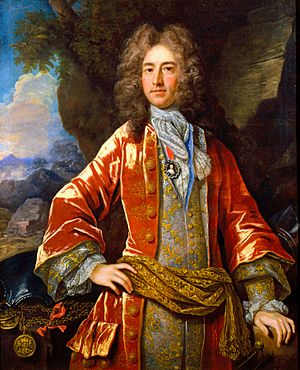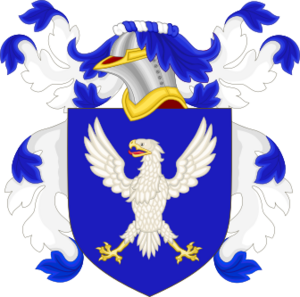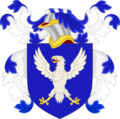Daniel Parke facts for kids
Quick facts for kids
Daniel Parke Jr.
|
|
|---|---|

A portrait of Parke by John Closterman
|
|
| Governor of the Leeward Islands | |
| In office 1706–1710 |
|
| Monarch | Queen Anne |
| Preceded by | John Johnson |
| Succeeded by | Walter Hamilton |
| Personal details | |
| Born | 1664 Queen's Creek, Virginia |
| Died | December 7, 1710 (aged 45–46) Antigua, Leeward Islands |
| Spouse | Jane Ludwell (m. 1685) |
| Children | 5, including Lucy |
| Parents | Daniel Parke Sr. Rebecca Evelyn |
| Profession | Military officer, planter, politician, colonial administrator |
| Military service | |
| Allegiance | |
| Rank | Colonel |
| Battles/wars | |
Daniel Parke Jr. (born 1664 – died December 7, 1710) was an important figure in early American history. He was born in America and became a military officer, a farmer (planter), a politician, and a leader in the colonies. From 1706 to 1710, he served as the governor of the Leeward Islands.
Parke was well-known for his military service in Europe. He fought alongside the famous Duke of Marlborough during the War of the Spanish Succession. Sadly, Parke is also remembered as the only governor in Britain's American colonies to be killed while in office. He died in 1710 during an attack by a group of people in Antigua.
Contents
Who Was Daniel Parke Jr.?
Daniel Parke Jr. was born in 1664 in the English colony of Virginia. He likely grew up on his father's large farm (plantation) in Queen's Creek, York County. His father, Daniel Parke Sr., was a merchant from London who became a successful farmer and politician in America. His mother, Rebecca Knipe, was related to the famous diarist John Evelyn.
When he was young, Daniel Parke Jr. was sent to England for his education. He lived with his mother's family there. In 1674, he returned to Virginia. Five years later, his father passed away.
In 1685, Parke married Jane Ludwell. Her father, Philip Ludwell, was also an important colonial official. A few years later, Parke traveled back to England with Ludwell. They went to complain about the behavior of the royal governor of Virginia, Nathaniel Bacon.
After two years in England, Parke returned to Virginia in 1692. He started a career in politics. In 1693, he was elected to the House of Burgesses. This was an important law-making group in Virginia. In 1695, he was appointed to the Virginia Governor's Council. This was a group of advisors to the governor. Parke often had disagreements with other politicians. Because of these issues, he moved back to England in 1701.
Parke's Military Adventures
In 1702, England joined the War of the Spanish Succession against France. Parke joined the English Army as an aide-de-camp. This meant he was a personal assistant to a senior commander. He worked for John Churchill, 1st Earl of Marlborough. Marlborough was a very important leader in the army.
Parke went with Marlborough to the Low Countries. There, Marlborough led a large army of English, Dutch, and German soldiers. During the war, Parke was called "Colonel." However, some historians say there's no official record of him holding this rank in the English Army. It's possible he earned the title in the Virginia militia. Parke tried to get an official officer's job in the English Army, but he was never successful.
Battles and Bravery
On July 2, 1704, Parke fought in the Battle of Schellenberg. This was a big victory for Marlborough's army against French and Bavarian forces in Germany. During the battle, Parke was injured in both ankles while attacking a hill.
Despite his injuries, he recovered quickly. On August 13, 1704, he was with Marlborough again. They fought in the Battle of Blenheim, another major battle near the village of Höchstädt. This battle was also a big win for the allied forces.
After the Battle of Blenheim, Marlborough wrote a message to Queen Anne. It told her about the great victory. He gave the message to Parke and asked him to deliver it to the Queen in London. Parke rode on horseback for eight days without stopping! He personally gave the message to Queen Anne at Windsor Castle.
The Queen was very grateful for Parke's bravery. She gave him a special gift: a small portrait of herself decorated with jewels. She also gave him 1,000 pounds every year and thanked him personally.
Becoming a Governor
Parke believed Marlborough had promised him the job of governor of Virginia. However, when he returned to England, he found out that someone else had been appointed. Parke was very upset. He asked for a similar important job.
He was then offered the position of governor of the Leeward Islands. These were a group of English colonies. Parke didn't really want the job. He wrote that it was "the hardest taske of all the Queen's Governors, tho' the least sallary" (meaning it was the hardest job with the lowest pay). But he accepted it anyway.
Leading the Leeward Islands
On July 14, 1706, Parke arrived by ship in the English colony of Antigua. As the new governor, his first task was to improve the defenses of the Leeward Islands. He wanted to protect them from French attacks by sea. He also worked hard to stop smuggling by local farmers. However, Parke was very direct and sometimes lacked good manners.
He quickly made enemies with some powerful people in the colonies. This included another leader named Christopher Codrington. Parke used his power to take over some of Codrington's properties. In return, Codrington encouraged people to be unhappy with Parke.
Parke was surprised by how lawless the Leeward Islands seemed. He started a campaign to bring more order and rules to the region. During his time as governor, some unhappy colonists even tried to kill him twice.
In early December 1710, the governor's council asked Parke to gather the colonial legislature. They wanted to discuss a possible French invasion during the ongoing war. Parke and the legislature had many disagreements. The legislature asked him to leave Antigua and let the colonists manage their own defenses. Parke refused.
A group of angry colonists then decided to remove him from power by force. They called out the local militia (a group of citizen soldiers).
Parke's Final Moments
On December 7, 1710, a large, angry group of the Antiguan militia attacked Parke's home. His house was defended by a small group of soldiers and six of his friends. The militia quickly overpowered the soldiers. They then stormed the house and captured Parke. He was dragged outside his home and killed.
Parke's Family and Legacy
Historians describe Parke as a very "energetic, colorful, and argumentative character." He was strong-willed and often ignored what others thought. Even though he had a quick temper and often argued, Marlborough praised his military skills during the war. After Parke's death, Walter Douglas became governor in 1711. Douglas decided not to charge anyone involved in Parke's death.
Parke had three daughters with his wife, Jane: Frances, Lucy, and Evelin. His wife passed away in 1708. Evelin died in 1696. Frances married John Custis, and Lucy married William Byrd II, both in 1706.
Parke also had children with other women. He had a son named Julius with a woman named Mrs. Barry. He also had a daughter named Lucy with Catharine Chester. Parke recognized this Lucy as his child.
Besides his political work in Virginia, Parke tried to become a member of the English Parliament. He bought land in England to help him do this. He ran for election in 1701 but was not elected. When English officials learned about the problems with his rule in the Leeward Islands, they quietly supported the decision not to charge those who killed him.
After his death, there were disagreements about his properties in England, Virginia, and Antigua. Parke had some financial challenges. His legitimate daughters were upset about what he left to his son Julius. Some of his financial responsibilities were passed to his daughter Frances and her husband. Some of Parke's enslaved people were transferred to William Byrd II. His illegitimate daughter Lucy successfully fought in court for over thirty years to keep ownership of Parke's properties in Antigua.
Images for kids






